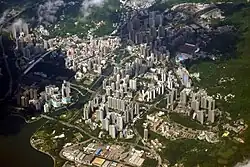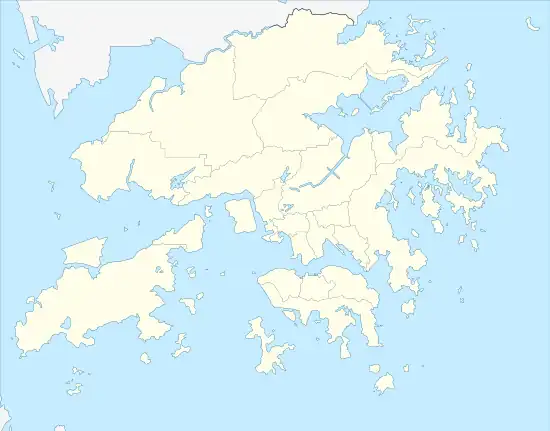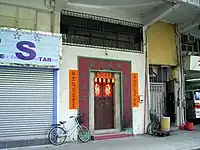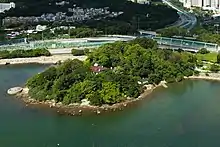Tai Po New Town
Tai Po New Town, or Tai Po Town, is a new town (satellite town) and non-administrative area in Tai Po District, in the New Territories, Hong Kong. The area is a planned town that surrounding the existing indigenous market towns Tai Po Hui (literally Tai Po Market, was known as Tai Wo Shi in the 1900s) and Tai Po Kau Hui (Tai Po Old Market), as well as east of the existing indigenous villages that located on the Lam Tsuen Valley as well as west of those villages in Ting Kok and Tai Mei Tuk and south of those villages in Nam Hang, Fung Yuen and Sha Lo Tung. Most of the lands of the new town were obtained by land reclamation. In present day, Tai Po New Town was simply known as Tai Po.[1]: 227 The new town are largely covered by the government Tai Po Outline Zoning Plan, which legally regulated the land use of the area, on top of the terms in the land lease contract with the government. Some of the land lease within the area, were known as Tai Po Town Lot № foo. In election, the town had a different zoning scheme for the election constituencies.
Tai Po New Town
大埔新市鎮 | |
|---|---|
 Aerial view of Tai Po New Town | |
| Etymology: name after the historic market town Tai Po Market | |
| Nickname: Tai Po | |
 Tai Po New Town | |
| Coordinates: 22°26′41″N 114°10′14″E | |
| Country | China |
| Provincial-level SARs | Hong Kong |
| Regions | The New Territories |
| District | Tai Po District |
| Time zone | UTC+8 |
| Tai Po New Town | |||||||||||||
|---|---|---|---|---|---|---|---|---|---|---|---|---|---|
| Traditional Chinese | 大埔新市鎮 | ||||||||||||
| Simplified Chinese | 大埔新市镇 | ||||||||||||
| |||||||||||||
| Tai Po Town | |||||||||||||
| Chinese | 大埔市 | ||||||||||||
| |||||||||||||
History of developments




The new town was designed to be expanded from and incorporate the previously existing areas of Tai Po Market (Tai Po Hui; formerly known as Tai Wo Shi) and Tai Po Old Market (Tai Po Kau Hui, the former site of Tai Po Hui), traditional market towns that served both rural villages of Tang clan Tai Po branch and non-Tang's village alliance Tai Po Tsat Yeuk (literally Tai Po Seven Alliances) as well as people by water route from Ma On Shan and other places. The market towns were established in the Qing dynasty. After the concession of the area now known as the New Territories and New Kowloon to the British Empire, the colonial Hong Kong government also established the District Office North (founded as District Office which also oversee villages that belongs to the present day Sha Tin District), an administrate department, in the area that belongs to the modern day Tai Po New Town in 1907. The building was next to the former site of the Tai Po police station, as well as the Island House, the residence of the District Officer. The market towns received expansion in the 1960s, due to the relocation of indigenous villages to the newly reclaimed land that next to the Tai Po Market, as well as the construction of Tai Po Industrial Estate which started in 1974.[2]: 273 From 1976, [sic][3]: 265 extensive reclamation work was carried out near the mouth of the Lam Tsuen River in Tolo Harbour (or known as Tai Po Hoi, literally Tai Po Sea) in order to create land for the new town.
The new town was a planned area, which " suitable sites have been reserved for various types of land-uses including residential, commercial, industrial and open space, and for the provision of different types of community and infrastructural facilities to meet the needs of the population."[4] The new town was divided between residential and industrial areas, with a mix of public and private housing. The Tai Po Industrial Estate southwest of Ting Kok is one of the major industrial estates in Hong Kong. The gas factory of Hong Kong and China Gas was located in the estate.[4] As of 2018, the estate also consists of tenants such as Asia Television, AsiaSat, APT Satellite, Oriental Press Group, South China Morning Post Publishers etc.. Tai Po New Town also had a smaller industrial area known as Tai Ping Industrial Centre.
The new town was served by two railway stations (now part of the mass transit system of the city), new Tai Po Market station and Tai Wo station respectively. Tai Po Kau railway station and old Tai Po Market railway station, however, were closed in 1983.[2]: 277 The latter which previously served the traditional market town Tai Po Market (Tai Wo Shi), became the Hong Kong Railway Museum, one of the public museums of Tai Po District. In terms of road transport, Tolo Highway was completed in the 1980s, which largely replaced Tai Po Road as the main road between the new town and city centre.
One of the earliest development of the present day Tai Po new town, were multi-storied estates on newly reclaimed land on Kwong Fuk Road circa the 1960s to 1970s. The housing estates, known as Luk Heung San Tsuen were served as the compensation for villages that were suffered from the construction of the Plover Cove Reservoir (船灣淡水湖; 'boat bay fresh water lake'), in which the farmland would be under water after the construction of the reservoir.[2]: 273 Despite those buildings are now much older than other buildings of the new town, as well as now part of the Tai Po District Council Election Constituency Tai Po Hui,[5] the area could traced back to its origins in the Plover Cove by the name of the local street Luk Heung Lane (陸鄉里), a namesake of Luk Heung (literally Six Villages), as well as an ancestral hall. Those villages from Luk Heung conducted their business activities in Sha Tau Kok market town in the past. The Lane-Square in Tai Po, or known as the "Four Lanes" were also built circa the 1960s.
In 1972, the Executive Council, the de facto cabinet of the Hong Kong colonial government, had approved a 10-year housing plan, which included a proposed expansion of Tai Po, Fanling–Sheung Shui-Shek Wu Hui and Yuen Long as new towns.[6]
In 1976, Tai Po New Town project was formally announced.[2]: 273 Differ from Luk Heung San Tsuen, which was a relocation of rural population to the rural town centre, the new town project was an influx of urban population from the existing built-up area of the city.[2]: 275
In 1980, the first public rental housing estate of the new town, Tai Yuen Estate, was completed.[2]: 275 It was followed by Fu Heng Estate, Fu Shin Estate, Kwong Fuk Estate, Tai Wo Estate and Wan Tau Tong Estate (in alphabetical order); Po Heung Estate was the latest public rental housing estate of Tai Po[7] in the Tai Po Market area as a re-development project of existing public facility of the traditional market town.[8] The establishment of Tai Wo Estate and Tai Wo station, also shifted the area that corresponded to the name Tai Wo, from Tai Po Market (was established as Tai Wo Shi; at the time of establishment, Tai Po Old Market was known as Tai Po Market) to the area around Tai Wo Estate.[9] The new town also composed of many private housing estates, as well as public-private housing estates that were subsidized under the Home Ownership Scheme.
The New Town project also made Yuen Chau Tsai fishing village obsoleted. Fishermen that formerly lived on their boats, were relocated in the 1970s, initially to the temporary housing area such as Yue Kok (漁角; 'fishing corner'), and then public housing estate.[2]: 275 Yuen Chau Tsai now known for Island House, a fishermen temple Tai Wong Yeh Temple, and nearby Yuen Chau Tsai Park.
Wong Shiu Chi Secondary School, SKH Bishop Mok Sau Tseng Secondary School and Carmel Pak U Secondary School, all subsidized secondary schools, was founded in 1960, 1975[10] and 1979 respectively. Tai Po Government Secondary School, was founded in 1984 and folded in 2014. As of 2018, there were 19 secondary schools in the whole Tai Po District,[11] all within the Tai Po New Town.
Alice Ho Miu Ling Nethersole Hospital, was relocated to Tai Po New Town in 1997.[12] The town was previously served by the Prince of Wales Hospital in the Sha Tin District. In 1997, the Hong Kong Institute of Education, a tertiary public school, moved to its Tai Po new campus. Both facilities were built on existing hilly area of the new town.
According to the Civil Engineering and Development Department of Hong Kong, Hong Kong Science Park in Pak Shek Kok, was also within the scope of Tai Po New Town.[13] However, in later document, the new town project was renamed to "Tai Po New Town and Pak Shek Kok Development".[14] Pak Shek Kok was served by the University station of MTR.
In urban planning
In the Town Planning Board of Hong Kong, the area was known as "Tai Po Outline Zoning Plan" (Tai Po OZP).[15] The zoning plan roughly covered the Tai Po New Town (including Tai Po Industrial Estate), as well as Tai Po Market and Tai Po Old Market. The zoning plan also covered some of the indigenous villages of Tai Po District, but indigenous villages on the Lam Tsuen Valley, were regulated by Lam Tsuen Outline Zoning Plan instead.[16] The aforementioned science park and surrounding residential area in Pak Shek Kok, had its own OZP: Pak Shek Kok (East) Outline Zoning Plan. Other area of the Tai Po District, such as northern Sai Kung Peninsula were belonged to other OZPs of the board.
Scrapped facilities
It was reported that the area of the modern day Tai Wo Estate, a public housing project in the west edge of the new town, was planned for industrial use.[17] However, the plan was scrapped in 1983.[18]
The new town currently had a public auditorium and theatre, Tai Po Civic Centre, which was opened in 1985 on On Pong Road,[19] next to private housing estate Tai Po Centre. A larger facility, Tai Po Town Hall (大埔大會堂), which could compare to Sha Tin Town Hall, was planned in the new town, east of private housing estate Plover Cove Garden (寶湖花園). However, the construction of such facility was scrapped or postponed indefinitely.[20] Another facility, Tai Po Public Library, was separated from the planned town hall, and incorporated into Tai Po Complex, a new government building that was completed in 2004.[21] The complex was a re-development project within the older area of Tai Po in Tai Po Market. Government had used part of the shopping centre of Plover Cove Garden as the temporary site of the public library for more than a decade. In 2016, government proposed to built Tai Po Sports Centre, Tai Po Community Hall and two 7-a-side football fields,[22] on the existing planned site of Tai Po Town Hall.
Future developments
In 2012, Hong Kong government proposed 25 new land reclamation sites in a public consultation.[23][24] In those 25 sites, some of them are located in the Tai Po District which near to the existing Tai Po new town. In particular, the residents of Tai Po against the sites near Plover Cove, Tai Po Waterfront Park and Tai Po Kau by forming online interest group.[25] Another proposed site near Pak Shek Kok in the Tolo Harbour, had also gathered more than 3,000 signatures in a petition.[26] Of those 25 sites, only 6 of them were included in the stage 2 public consultation, which only included the aforementioned the Tolo Harbour, but excluding the three other sites that near to the Tai Po New Town. In 2018, one of the 6 sites in the stage 2 consultation, became a new project known as Lantau Tomorrow Vision. However, many citizen and environmental protection organization against the project. Our Hong Kong Foundation, a pro-government think tank, had employed Hong Kong Institute of Asia-Pacific Studies of the Chinese University of Hong Kong to conduct a survey. The survey shown 45.3% agreed reclamation outside the Victoria Harbour, while 33.9% against.[27] In February 2019, the government announced that "it has fully accepted the recommendations tendered by the Task Force on Land Supply," including using reclamation as a mean to obtain new lands for development.[28] However, it was also announced that the reclamation plan of Ma Liu Shui in Tolo Harbour was postponed, despite it was included in the recommendations by the Task Force.[29][30] Thus, it was uncertain that the reclamations in the water of Tolo Harbour would go ahead or not.
Cityscape

See also
- Tai Wo: a place name in Tai Po New Town, which the name was referred to Tai Po Market in the past but currently refer to Tai Wo Estate
References
- 萬里地圖製作中心, ed. (2016). 香港大地圖 [Complete City Guide of Hong Kong] (in Chinese (Hong Kong)) (2017 ed.). Wan Li Book (Sino United Publishing Group). ISBN 9789621460318. Retrieved 25 December 2018.
- Cheng Siu Kei (2008). "Making of a New Town: Urbanisation in Tai Po" (PDF). In Wong Wing Ho; Liu Tik-sang; Cheung Siu-woo; Siu, Susanna L.K. (eds.). Traditions and Heritage in Tai Po. Tai Po District Council. ISBN 978-988-17802-2-5. Archived from the original (PDF) on 21 August 2010.
- 何佩然 (July 2016). 城傳立新──香港城市規劃發展史(1841-2015) (in Chinese (Hong Kong)). Hong Kong: Chung Hwa Book. ISBN 978-988-8420-02-5. Retrieved 25 December 2018.
- "Tai Po: Government Planned Development". Planning Department of the Hong Kong Government. November 2002. Retrieved 25 December 2018.
- "District Council Election Constituency Boundaries – Tai Po District (Sheet 1)" (PDF). Electoral Affairs Commission. 2014. Retrieved 18 September 2018.
- "Introduction". Market Towns (PDF) (scanned copy). New Territories Development Department of Public Works Department of Hong Kong Government. 1979 [n.d. on digital edition]. p. 1. Retrieved 26 December 2018 – via The University of Hong Kong Libraries.
- 大埔區內新落成屋邨僅得500伙. instant news section. on.cc (in Chinese (Hong Kong)). 17 June 2017. Retrieved 11 March 2019.
- 文森 (28 June 2017). 搬入「回歸邨」如中六合彩 (PDF). Wen Wei Po (in Chinese (Hong Kong)). Hong Kong. Retrieved 11 March 2019.
- 萬里地圖製作中心, ed. (July 2017). 香港大地圖 [Complete City Guide of Hong Kong] (in Chinese (Hong Kong)) (2018 ed.). Wan Li Book (Sino United Publishing Group). ISBN 978-962-14-6420-0. Retrieved 19 September 2018.
- "School Profile". Tai Po, Hong Kong: SKH Bishop Mok Sau Tseng Secondary School. Retrieved 25 December 2018.
- "Secondary School Places Allocation System 2016/2018 Secondary School List NET NT6 (Tai Po District)" (PDF). The Education Bureau of Hong Kong Government. Retrieved 25 December 2018.
- "Alice Ho Miu Ling Nethersole Hospital". Hong Kong: Hospital Authority. Retrieved 25 December 2018.
- "Achievements & New Developments > Regional Development Services > Tai Po New Town". Civil Engineering and Development Department of Hong Kong Government. 2004. Archived from the original on 12 November 2004. Retrieved 25 December 2018.
- "Achievements > Regional Development > Tai Po New Town and Pak Shek Kok Development". Civil Engineering and Development Department of Hong Kong Government. 26 September 2017. Retrieved 25 December 2018.
- "Approved Tai Po Outline Zoning Plan Amended". Hong Kong: Town Planning Board. 4 August 2017. Retrieved 25 December 2018.
- https://www2.ozp.tpb.gov.hk/
- "Tai Po Development general land use proposal". Market Towns (PDF) (scanned copy). New Territories Development Department of Public Works Department of Hong Kong Government. 1979 [n.d. on digital edition]. p. 2. Retrieved 26 December 2018 – via The University of Hong Kong Libraries.
- 發展西貢北約成新市鎮. Wah Kiu Yat Po (in Chinese (Hong Kong)). Hong Kong. 25 October 1984. p. 21.
- "Introduction". Tai Po Civic Centre. 11 July 2018. Retrieved 25 December 2018.
- "OFFICIAL RECORD OF PROCEEDINGS" (PDF). Legislative Council of Hong Kong. 22 November 2000. Retrieved 25 December 2018.
For example, in the Tai Po DC, of which I am a member, DC members have been fighting for the construction of a Tai Po Town Hall. Over 10 years have passed now, it appears it takes forever for the hall to be constructed. When I was elected a Tai Po District Board member in 1991, the Tai Po District Board then agreed that the matter be raised with the Government for a second time. The Government then earmarked a piece of land for the construction. I hope the relevant government department can honour its earlier promise so that residents living in Tai Po may enjoy the services of a new cultural centre and a new central library as soon as possible
- "New sports centre, library to better serve Tai Po" (Press release). Hong Kong Government. 18 December 2004. Retrieved 25 December 2018.
- "LC Paper №CB(2)788/15-16(01): Sports centre, community hall and football pitches in Area 1, Tai Po" (PDF). Panel on Home Affairs, Legislative Council of Hong Kong; Home Affairs Bureau of Hong Kong Government. January 2016. Retrieved 25 December 2018.
- Chan, Paul (21 November 2012). "LCQ6: Reclamation outside Victoria Harbour" (transcript). Legislative Council of Hong Kong. Retrieved 25 December 2018.
- Report on Stage 1 Public Engagement – Executive Summary (PDF). Enhancing Land Supply Strategy – Reclamation outside Victoria Harbour and Rock Cavern Development. Civil Engineering and Development Department of Hong Kong Government; Arup. January 2013. Retrieved 25 December 2018.
- 填海選址減至10個. The Sun (in Chinese (Hong Kong)). Hong Kong: Oriental Press Group. 5 April 2012. Retrieved 25 December 2018.
- Ng, Joyce (30 March 2013). "Students petition against harbour reclamation". South China Morning Post. Hong Kong. Retrieved 25 December 2018.
- 陸振球 (3 May 2018). 【陸振球專欄】贊成填海民意遠高於反對. Online instant news edition. Ming Pao (in Chinese (Hong Kong)). Hong Kong. Retrieved 25 December 2018.
- "Government responds to report of Task Force on Land Supply (with photos)" (Press release). Hong Kong Government. 20 February 2019. Retrieved 12 March 2019.
- 發展局:暫緩馬料水填海 現階段不發展郊野公園邊陲地. online instant news section. Ming Pao (in Chinese (Hong Kong)). Hong Kong: Media Chinese International. 20 March 2019. Retrieved 11 March 2019.
- 黃遠輝:馬料水填海值得做 黃偉綸:研究有否更好方案 (in Chinese (Hong Kong)). Radio Television Hong Kong. 21 February 2019. Retrieved 12 March 2019.
External links
- Tai Po. Pamphlets on Planning for New Territories. Planning Department of Hong Kong Government. 2002.
- About Tai Po New Town